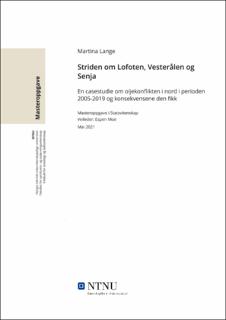| dc.contributor.advisor | Moe, Espen | |
| dc.contributor.author | Lange, Martina | |
| dc.date.accessioned | 2021-09-28T17:33:59Z | |
| dc.date.available | 2021-09-28T17:33:59Z | |
| dc.date.issued | 2021 | |
| dc.identifier | no.ntnu:inspera:80180200:26364891 | |
| dc.identifier.uri | https://hdl.handle.net/11250/2784556 | |
| dc.description.abstract | Denne oppgaven undersøker hvorfor det ikke har blitt åpnet for petroleumsaktivitet i havområdene utenfor Lofoten, Vesterålen og Senja (Nordland VI, Nordland VII og Troms II), og hvilke implikasjoner dette har hatt for øvrig norsk petroleumsaktivitet. Studien dekker tidsrommet 2005-2019, men gir en grundig redegjørelse for hendelsene som ledet opp til dette. Oppgaven benytter seg av Advocacy coalition framework for å tilnærme seg dette spørsmålet. Studien er en casestudie, som baserer seg på dokumentanalyse og tolv elite-intervjuer. Denne oppgaven forsøker å gi en økt forståelse for en av de viktigste manifesteringene av vekst versus vern skillelinjen i norsk politikk. En case som er viktig både for å forstå norsk miljøpolitikk og norsk petroleumspolitikk, og kan sees som forløperen til dagens debatt om fortsatt leteaktivitet på norsk sokkel. Den bidrar også med en studie av maktbalansen i norsk petroleumspolitikk.
Studien konkluderer med at Arbeiderpartiets beslutning om å inngå i en samarbeidsregjering i 2005 førte til etableringen av blokkpolitikken i Norge. Dette ga økt makt til de mindre partiene på stortinget, som brukte denne makten til å fremforhandle avtaler om midlertidig vern av havområdene utenfor Lofoten, Vesterålen og Senja (Nordland VI, Nordland VII og Troms II). Dette endret seg da Arbeiderpartiet skiftet standpunkt i saken i 2019, etter lang intern strid om spørsmålet. Saken hadde da blitt svært belastende for partiet. Den midlertidige verningen av Nordland VI, Nordland VII og Troms II har ført til at petroleumsnæringen har blitt kompensert med tilgang til leteområder andre steder på norsk sokkel. | |
| dc.description.abstract | This thesis investigates why petroleum activity has not been opened in the waters off Lofoten, Vesterålen and Senja (Nordland VI, Nordland VII and Troms II), and what implications this has had for other Norwegian petroleum activities. The study covers the period 2005-2019, but provides a thorough account of the events leading up to this. The study uses the Advocacy coalition framework to approach this issue. The study is a case study, which is based on document analysis and twelve elite interviews. The study seeks to provide an increased understanding of one of the most important manifestations of the growth-versus-protection divide in Norwegian politics. A case that is important both for understanding Norwegian environmental policy and Norwegian petroleum policy, and can be seen as the precursor to today's debate on continued exploration activity on the Norwegian shelf. It also contributes with a study of the balance of power in Norwegian petroleum policy.
The study concludes that the Labor Party's decision to form a cooperative government in 2005 led to the establishment of block policy in Norway. This gave increased power to the smaller parties in the Norwegian Parliament, who used this power to negotiate agreements on temporary protection of the sea areas off Lofoten, Vesterålen and Senja (Nordland VI, Nordland VII and Troms II). This changed when the Labor Party changed its stance on the issue in 2019, after a long internal dispute on the issue. The issue had become a problem for the party. The temporary revival of Nordland VI, Nordland VII and Troms II has resulted in the petroleum industry being compensated with access to exploration areas elsewhere on the Norwegian shelf. | |
| dc.language | nob | |
| dc.publisher | NTNU | |
| dc.title | Striden om Lofoten, Vesterålen og Senja | |
| dc.type | Master thesis | |
